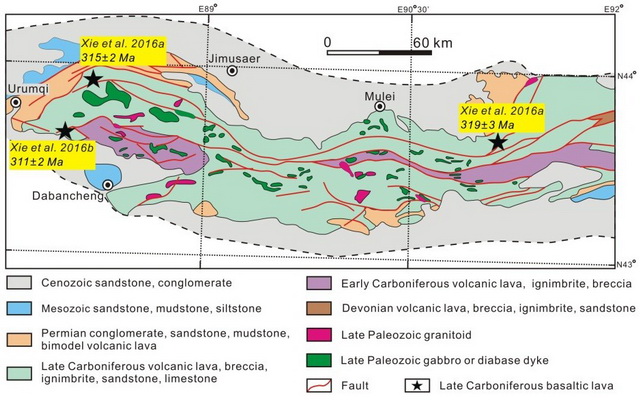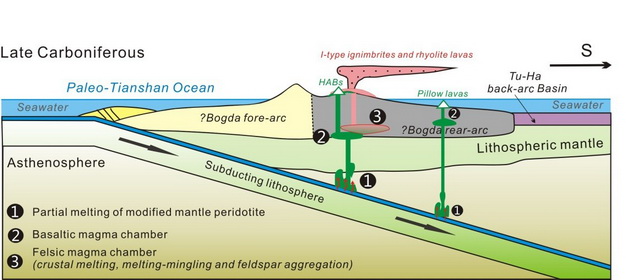| Research Hightlights |
| Events |
| Focus News |
| Upcoming Events |
| Location: Home > News > Research Hightlights |
| The Chinese North Tianshan Orogen was a rear-arc (or back-arc) environment in the Late Carboniferous: constraint from the two types of basalts in the Bogda area | TEXT SIZE: A A A |
Arc magmatism is thought to be a principal process in continental creation at least through the Phanerozoic (Davidson and Arculus, 2006). The Bogda–(Harlik) belt, the northern margin of Chinese North Tianshan, is thought as an ancient arc system between the Juggar Basin to the north and the Tu–Ha Basin to the south (Ma et al., 1997; Xiao et al., 2004; Chen et al., 2013). Thus, magmatism in the Bogda belt records pivotal information concerning Phanerozoic (especially Carboniferous–Permian) crustal growth of the Central Asian Orogenic Belt (CAOB; Seng?r et al., 1993; Jahn et al., 2000; Xiao et al., 2004, 2013; Windley et al., 2007; Safonova et al., 2011; Wilhem et al., 2012). Yet, the tectonic evolution in this region during the Carboniferous-Permian period remains debated, with main arguments including 1) a post-collisional orogenic belt as Paleo-Tianshan Ocean closed at the end of Early Carboniferous (Han et al., 2010, 2011; Chen et al., 2011); 2) a Carboniferous–Permian continental rift associated with a mantle plume (Gu et al., 2000, 2001; Xia et al., 2008, 2012); 3) a Carboniferous island arc system switched into a post-collisional orogenic belt in the Permian (Ma et al., 1997; Laurent-Charvert et al., 2003; Xiao et al., 2004; Yuan et al., 2010; Shu et al., 2011).
Here, we present new high-precise zircon SHRIMP U–Pb ages, petrology, mineralogy and geochemistry for the Late Carboniferous volcanics from the Bogda belt. Our results suggest that: 1) We find that a suit of high-Al basalt occurred at the Lower Carboniferous Liushugou Formation. High-Al basalt (HAB) refers to any sub-alkaline aphyric as well as porphyritic basaltic rock with Al2O3 > 16 %, which are generally associated with intra-oceanic arcs or mid-ocean ridges on a global scale (Tilley, 1950; Kuno, 1960; Crawford et al., 1987; Eason and Sinton, 2006; Ozerov, 2000; Sisson and Grove, 1993a). While a suit of submarine pillow basalt occurred at the Lower Carboniferous Qijiagou Formation. Precise zircon SHRIMP U–Pb dating suggests that the Bogda HABs and pillow lavas were erupted at 315-319 Ma and ~311 Ma, respectively.
2) Both the Bogda HABs and pillow lavas belong to the tholeiitic magma (the tholeiitic index THI > 1) and contain low pre-eruptive magmatic H2O (< 2%). High Al content of the Bogda HABs is due to high crystallization pressure rather than water content. And the sector and oscillatory zoning in Cpx phenocrysts is attributable to rapid dynamic crystallization during magma ascent. It is different from the pillow lavas that are formed in a shallower and more stable magma chamber. The felsic volcanics coexisted with the Bogda HABs are I-type intermediate ignimbrites and rhyolite lavas. The rhyolites are formed by partial melting of a hydrated and juvenile arc crust and the ignimbrites are affected by magma mingling and feldspar fractionation. Thus, the eruption of these volcanics is not bimodal volcanism, but their generation are related to bimodal magma (basaltic and rhyolitic magmas).
3) Both the two basalts have the MORB-like Sr-Nd-Hf-(Pb) isotopes and arc-like trace element compositions, indicating that they share a similar mantle source. The calculations suggest that both of them may have been generated from a dry and depleted mantle source metasomatized by <1% sediment-derived melts. Compared with those of Permian large igneous provinces (e.g., the Siberia, Emeishan and Tarim basalts), the two Bogda basalts are different from the mantle plume-related basalts in many aspects. It suggests that the “plume hypothesis” cannot adequately be applied to the Carboniferous magmatism in the North Tianshan belt. Meanwhile, we also compare the Bogda basalts with the Izu-Bonin fore-arc and rear-arc/back-arc basalts. Our samples show great resemblance to the Izu-Bonin rear-arc basalt (including the arc-like back-arc basalt). These lines of evidence indicate that these basalts and coexisted felsic volcanics were likely formed in a rear-arc or back-arc environment, probably related to southward subduction of the Paleo-Tianshan Ocean.
Fig.1 Geological map of the Bogda belt at the north margin of the Chinese North Tianshan, modified after Chen et al. (2011) and Zhao et al. (2014).
Fig.2 Idealized schematic model for the generation of the Bogda volcanics beneath the Bogda arc-back-arc system in Late Carboniferous. Please see: [1] Xie, W., Xu, Y.-G., Chen, Y.-B., Luo, Z.-Y., Hong, L.-B., Ma, L., Ma, Q., Liu, H.-Q., 2016a. High-alumina basalts from the Bogda Mountains suggest an arc setting for Chinese Northern Tianshan during the Late Carboniferous. Lithos 256-257, 165-181. [2] Xie, W., Luo, Z.-Y., Xu, Y.-G., Chen, Y.-B., Hong, L.-B., Ma, L., Ma, Q., 2016b. Petrogenesis and geochemistry of the Late Carboniferous rear-arc (or back-arc) pillow basaltic lava in the Bogda Mountains, Chinese North Tianshan. Lithos 244, 30-42. [3] Xie, W., Xu, Y.-G., Chen, Y.-B., Luo, Z.-Y., Hong, L.-B., Ma, L., Ma, Q., Liu, H.-Q., 2016c. Petrogenesis and geodynamic implications of the Late Carboniferous felsic volcanics in the Bogda belt, Chinese Northern Tianshan. Gondwana Research 39, 165-179.
Article Links:Lithos Lithos Gondwana Research
|
||
|
|
||

